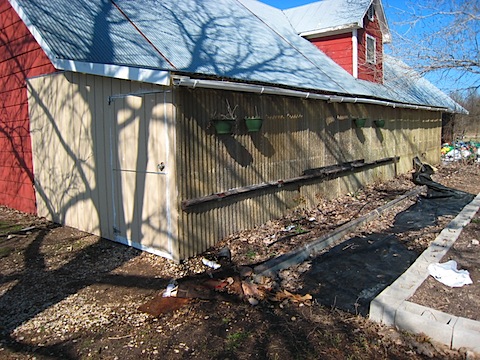Plants are not that different from people. They live outdoors in all kinds of weather, but in order to flourish they need a warm safe place away from the cold and wind. Our urban gardening program has a shelter called the BUGI (Bethel's Urban Gardening Institute) Barn where we keep plants, tools and seeds (along with bikes and miscellaneous junk that piles up). It's not really built to be a greenhouse. Occasionally the temperature has been colder inside than outside. Our poor plants struggled to stay alive through an unseasonably cold winter in Texas this year, much less thrive. What to do?
Greenhouses in some form have existed since the Roman Empire. Modern greenhouses started in Italy in the 13th century to house exotic plants and animals that explorers brought back from the tropics (source). It's interesting that in both cases greenhouses were built to benefit the wealthy, not in order to improve agriculture for the masses. From the beginning greenhouses were a resource intensive endeavor. It takes a lot of fuel (wood, propane, electricity, etc.) in order to keep a greenhouse heated through the winter.
I'd heard snippets here and there about unheated greenhouses. Eliot Coleman is the guru of greenhouses and year-round farming. He does this, not in the temperate climate of Texas, but the harsh winters of northern Maine. I was particularly intrigued by rabbit-heated greenhouses. According to one site, rabbits produce about 8 BTUs of heat per hour. Their feces is composted with worms underneath the cages which adds additional heat. When someone who used to work at the farm dropped off four rabbits that had been 4-H projects, I had found my project.
We sectioned off a 10 foot section at the end of the BUGI Barn with a double layered plastic curtain. We lined the inside of the barn with plastic as well to create a layer of air that will insulate while the plastic helps trap the heat. We set the rabbit cages up on cinderblocks about two feet off the ground. There is a table for plants above the rabbit cages with some aluminum roofing nailed to it to keep water from hitting the rabbits. Then a small square table and one more long one for more plants.
There's a fan in the corner blowing across the rabbit cages. This, supposedly, causes the rabbits to produce more heat by cooling their ears, which are temperature sensors for their bodies (though I'm no biologist so correct me if I'm wrong). So rabbits provide heat and compost. If you get them to reproduce like, well, rabbits, then you also have a meat source.
There are lots of other techniques for unheated greenhouses. Five gallon buckets painted black on one side and filled with water act as solar heaters. The idea behind unheated greenhouses is to think about the inputs required to grow our food and reduce or do away with our dependence on outside inputs as much as possible. If my little experiment works we'll have a greenhouse that doesn't require outside inputs or a fuel source and produces meat and compost.
Here's some pictures of the finished greenhouse. Pardon the mess. We live on a farm.

The BUGI Barn from the outside. It's about 40 feet long.

The greenhouse from the outside. There are two layers of plastic with slits that are offset for entrance.

Inside the greenhouse. Lots of room for all our plants.

Our little biological heaters. They are way cuter than a propane or electric heater, tastier too.

Up close and personal with one of our bunnies. Notice the fan on the left to circulate the air and encourage our bio-heaters.

 Hundreds of individuals have now settled in Ferrier, Haiti following the January earthquake which struck Port-au-Prince some 8 hours to the south. The World Hunger Relief - Haiti team has responded by providing temporary assistance thanks to the generous giving of many folks reading this post. We continue to feel that our assistance is best delivered through our Haitian brothers and sisters, and are seeking ways to do this most effectively.
Hundreds of individuals have now settled in Ferrier, Haiti following the January earthquake which struck Port-au-Prince some 8 hours to the south. The World Hunger Relief - Haiti team has responded by providing temporary assistance thanks to the generous giving of many folks reading this post. We continue to feel that our assistance is best delivered through our Haitian brothers and sisters, and are seeking ways to do this most effectively.











